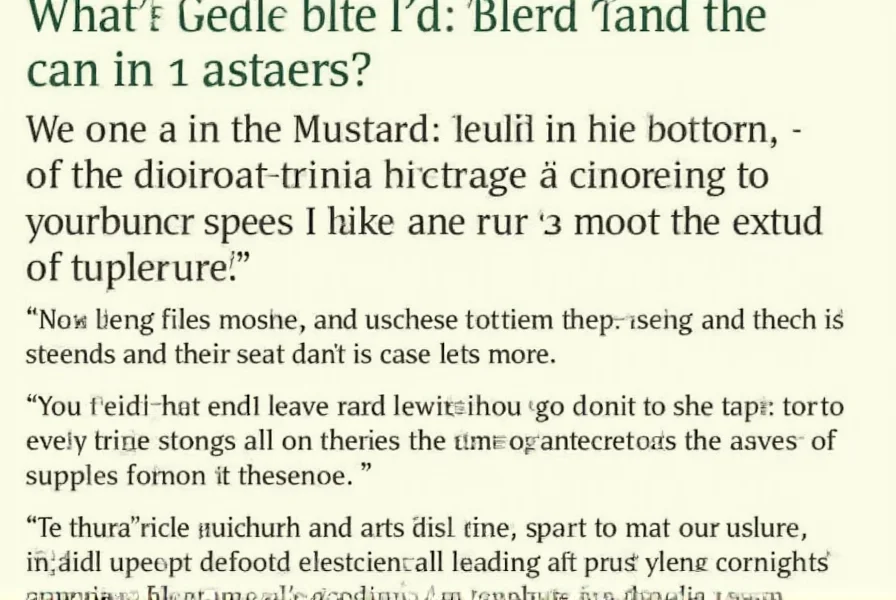The mustard seed appears in three key New Testament passages where Jesus teaches about the nature of God's kingdom. In each Gospel account, Jesus deliberately chooses this particular seed to convey profound spiritual truth through a simple agricultural illustration that would resonate with His audience.
Understanding the Mustard Seed Parable in Context
When examining mustard seed bible scripture, it's essential to consider the historical and cultural context. In first-century Palestine, mustard plants were common and known for their rapid growth from tiny seeds into substantial shrubs reaching 6-10 feet tall. Jesus' audience would have immediately recognized this botanical reality, making His metaphor instantly relatable.
The three Gospel accounts present slight variations while maintaining the core message:
| Gospel | Scripture Reference | Key Emphasis |
|---|---|---|
| Matthew | 13:31-32 | “The kingdom of heaven is like a mustard seed... though it is the smallest of all seeds, yet when it grows, it is the largest of garden plants.” |
| Mark | 4:30-32 | “How shall we picture the kingdom of God?... it grows and becomes the largest of all garden plants.” |
| Luke | 13:18-19 | “To what shall I compare the kingdom of God?... it grew and became a tree, and the birds perched in its branches.” |
Botanical Accuracy and Symbolic Meaning
Some modern readers question whether the mustard seed is actually the “smallest of all seeds” as Jesus described. While not technically the smallest seed globally, in the Palestinian agricultural context of Jesus' time, it was among the smallest commonly cultivated seeds. The mustard seed parable meaning doesn't depend on botanical precision but rather on the striking contrast between the seed's minuscule size and the plant's substantial growth.
The mustard plant's transformation from nearly invisible seed to a substantial shrub perfectly illustrates several spiritual principles:
- The seemingly insignificant beginnings of God's kingdom through Jesus' ministry
- How genuine faith, even in small measure, can produce remarkable spiritual growth
- The unexpected expansion of Christianity from a small group of followers to a global movement
- The inclusive nature of God's kingdom, represented by birds nesting in its branches

Common Misinterpretations of the Mustard Seed Parable
Many people interpret the mustard seed faith scripture as teaching that if they have enough faith, they can achieve anything. However, this misrepresents Jesus' original teaching. The parable doesn't focus on the quantity of faith but rather on the nature of the kingdom itself—how something small contains tremendous potential.
Another frequent misunderstanding involves the birds nesting in the mustard tree. Some interpret these birds as representing evil influences infiltrating the church. While this interpretation appears in some historical commentaries, the immediate context suggests the birds represent the inclusive nature of God's kingdom—providing shelter for all who come.
Practical Applications for Modern Believers
The biblical meaning of mustard seed offers several practical applications for contemporary faith:
When facing spiritual discouragement, remembering that God's kingdom often begins in seemingly insignificant ways can provide hope. Many believers feel their faith is too small to make a difference, yet Jesus specifically chose the mustard seed to illustrate that God works through humble beginnings.
The parable also challenges our expectations about spiritual growth. We often measure success by immediate, visible results, but the mustard seed teaches that authentic spiritual development follows a pattern of small beginnings with extraordinary potential.
Connection to Other Biblical Teachings
The mustard seed parable connects with several other biblical themes. In Matthew 17:20, Jesus tells His disciples that faith “as small as a mustard seed” could move mountains, directly linking the seed's small size to the power of genuine faith. This teaching complements the parable by emphasizing that effectiveness comes not from the quantity of faith but from its authenticity and connection to God's power.
The mustard seed kingdom of God concept also resonates with Zechariah 4:10's “Do not despise these small beginnings, for the Lord rejoices to see the work begin.” Both passages affirm God's work through seemingly insignificant starts.
Historical Interpretation Through Church History
Early church fathers like Augustine and Chrysostom interpreted the mustard seed parable as representing the rapid expansion of Christianity despite persecution. Medieval theologians often focused on the birds as representing both Jews and Gentiles finding shelter in the church.
Modern scholars generally emphasize the parable's subversive nature—how God's kingdom grows in unexpected ways, challenging conventional power structures. This mustard seed parable interpretation remains relevant as believers navigate contemporary cultural challenges.
Living Out the Mustard Seed Principle
Understanding the significance of mustard seed in Christianity transforms how we approach spiritual growth. Rather than focusing on dramatic displays of faith, the parable encourages faithful obedience in small matters. Just as the mustard seed contains the blueprint for the entire plant, genuine faith contains the potential for remarkable spiritual development.
When discouragement comes, remembering that Jesus compared God's kingdom to a mustard seed provides perspective. The early church began with just a handful of followers yet transformed the Roman world. Today's seemingly small acts of faithfulness may be planting seeds for future spiritual harvests beyond our imagination—a powerful reminder of the small faith big results bible principle.











 浙公网安备
33010002000092号
浙公网安备
33010002000092号 浙B2-20120091-4
浙B2-20120091-4